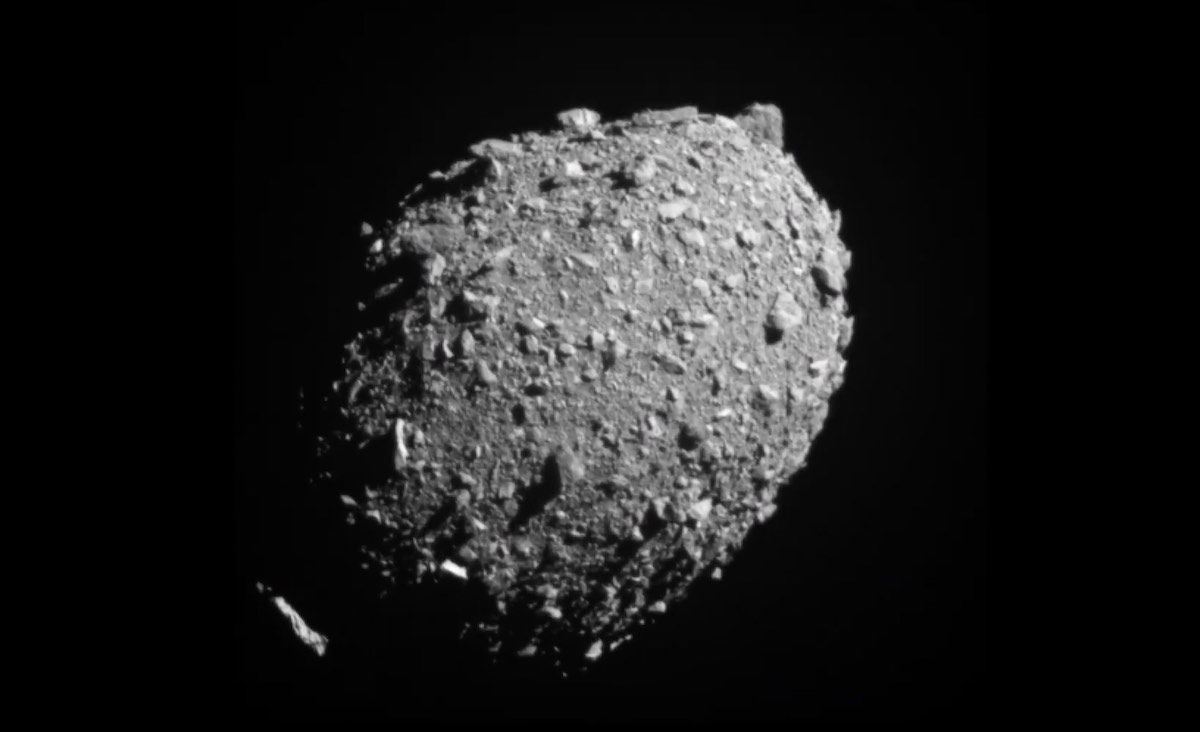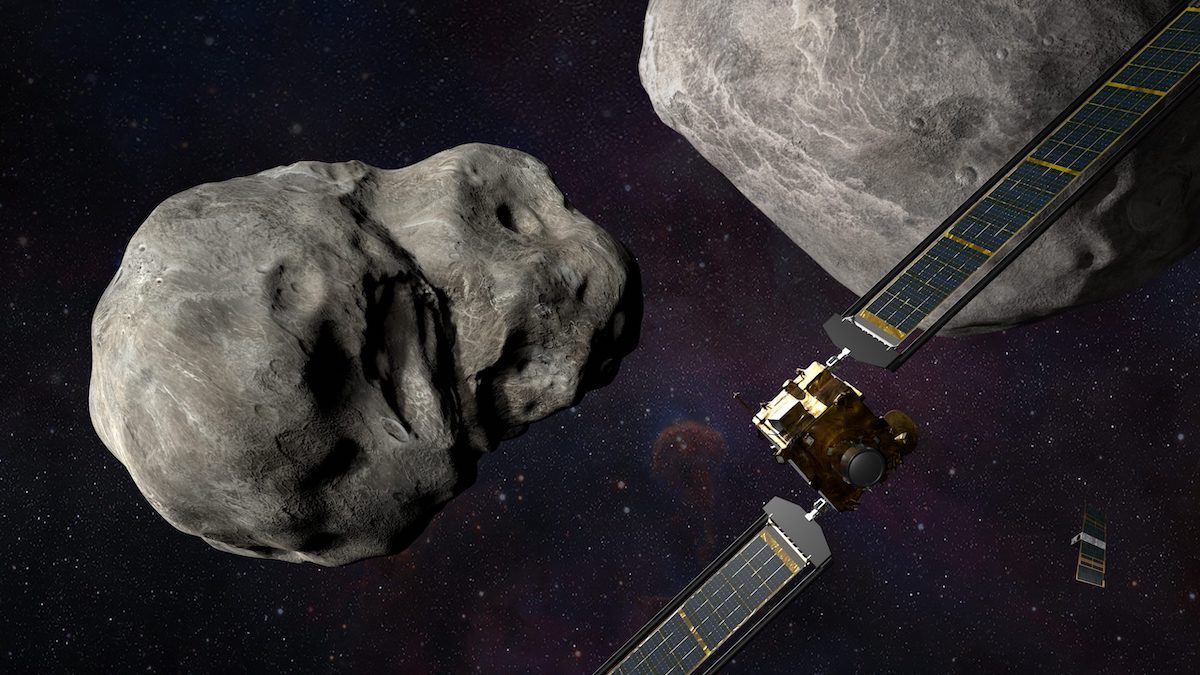
A $330 million NASA mission completed what amounts to an interplanetary game of darts Monday night with an on-target collision with a space rock nearly 7 million miles from Earth, testing a technique that scientists could use in the future to protect our home planet from a threatening asteroid.
Scientists were elated with the result Monday night, heralding as a turning point in humanity’s ability to protect Earth from threats from the sky. But it will take up to two months to precisely measure how much the impact of NASA’s Double Asteroid Redirection Test, or DART, spacecraft knocked its target asteroid off of its orbit.
“Congratulations! Boy, the DART team, you really did this one very well. … I believe it’s going to teach us how to one day protect our own planet from an incoming asteroid,” said NASA Administrator Bill Nelson. “So thank you to this international team. We are showing that planetary defense is a global endeavor, and it is very possible to save our planet.”
The DART spacecraft was the size of a vending machine — with a mass less than 1,300 pounds, or 600 kilograms — before it slammed into asteroid Dimorphos at a velocity of some 14,700 mph (6.6 kilometers per second). The collision destroyed the spacecraft and was expected to leave a crater on the surface of Dimorphos, an asteroid the size of a sports stadium that orbits a larger half-mile-side companion named Didymos.
The two asteroids, called a binary pair, are located about 0.6 miles (1 kilometer) from each other. Scientists will use telescopes on Earth to track the motion of Dimorphos around Didymos, and measure how much the kinetic energy imparted by the DART impact changed the orbit.
“Now is when the science starts,” says Lori Glaze, director of NASA’s planetary science division. “Now that we’ve impacted, now we’re going to see, for real, how effective we were. We’re going to train all those ground-based telescopes on the Didymos-Dimorphos system, and we’re going to make measurements that will help us determine just what its orbit looks like now relative to what it was before.”
“We’re embarking on a new era of humankind, an era in which we potentially have the capability to protect ourselves from something like a dangerous, hazardous asteroid impact,” Glaze said. “What an amazing thing. We’ve never had that capability before.”
DART hit Dimorphos at 7:14 p.m. EDT (2314 GMT) Monday to complete a 10-month flight since the spacecraft launched last November on a SpaceX Falcon 9 rocket from California.
“I definitely think that, as far as we can tell, our first planetary defense test was a success,” said Elena Adams, DART’s mission systems engineer at the Johns Hopkins University Applied Physics Laboratory in Maryland, which built and operated the spacecraft for NASA. “So, yeah, I think Earthlings should sleep better. Definitely I will!”
Mark Jensenius, a guidance engineer for DART’s SMART Nav navigation system, said the spacecraft guided itself to within 17 meters, or 56 feet, of the center of the sunlit portion of the asteroid. “This mission was straight down the middle of what our expectations were, and there we no adjustments needed,” he said.
If you missed the action earlier this evening, here’s a sped up replay from NASA’s DART spacecraft showing the final 10 minutes of its flight, culminating in a smash into asteroid Dimorphos nearly 7 million miles from Earth. https://t.co/OtCYO9ghol pic.twitter.com/CsMa6fLhWj
— Spaceflight Now (@SpaceflightNow) September 27, 2022
Dimorphos and Didymos pose no near-term threat to Earth, according to NASA. Scientists using ground-based telescopes will measure how the DART spacecraft’s collision changed the course of Dimorphos around Didymos, validating models of how a kinetic impactor in the future could nudge an asteroid off a path that would strike Earth.
Scientists expected about 2 million pounds of rock and dust from Dimorphos would be thrown into space, equivalent to about 0.02% of the asteroid’s estimated total mass.
Didymos and Dimorphos are officially classified as near-Earth asteroids, although scientists say there is no near-term threat from the pair. No space mission before DART had ever explored the asteroids, but scientists who have observed them through telescopes say the asteroids are about a half-mile (780 meters) and 525 feet (160 meters) in diameter, respectively.
Experts estimate there should be around 25,000 near-Earth asteroids the size of Dimorphos. An asteroid of that size that impacts Earth could wipe out a metropolitan area, causing mass casualties.
NASA says surveys have discovered around 40% of similar-sized near-Earth asteroids. Scientists have found more than 95% of the population of larger 1-kilometer-class (0.6-mile) near-Earth asteroids, which could wreak global damage if they hit our planet. The percentage is much lower for the smaller asteroids, but they pose a more limited risk.
The DART mission is the first project by NASA’s Planetary Defense Coordination Office, set up in 2016 to help detect, track, and potentially defend Earth against potentially hazardous asteroids.
NASA plans to launch its second planetary defense mission, an infrared telescope and follow-on to DART, in the late 2020s to find most of the undetected dangerous near-Earth asteroids.
“We’re not aware of a single object right now within the next 100 years or so that is really threatening the Earth,” said Thomas Zurbuchen, head of NASA’s science mission directorate. “But I’ll also guarantee to you that if you wait long enough, there will be an object.”
“Our work right now with the DART mission is one possibility of what we might do if we found an asteroid on an impact course with the Earth,” said Lindley Johnson, NASA’s planetary defense officer, before the mission launched last year. “So we’re testing this kinetic impactor technique, where we just ram a spacecraft into the asteroid at high velocity to shave a little bit of speed off of its path, and that changes into the future.”
A small speed adjustment could result in large changes in the asteroid’s location years or decades into the future, meaning that with enough warning, a relatively compact spacecraft could be all that is needed to safeguard Earth from an impact.
“Our objective is to find these objects far way in time and far away from Earth, and to be able to enact this change in their orbit many years in advance, so it doesn’t take much to change them at all,” Johnson said.
“This demonstration will start to add tools to our toolbox of methods that could be used in the future, and we need several of them because the circumstances that we might face could be quite different,” Johnson said. ”
The most effective deflection method would depend on the size of a potentially threatening asteroid, along with its orbit and when it might hit Earth,
“Some of the other things that have been studied are what we call a gravity tractor, which is just taking a spacecraft and station keeping with the asteroid and using nature’s tug rope, gravity, the mutual attraction between the spacecraft and the asteroid will slowly tug that asteroid out of its impacting trajectory into a more benign one,” Johnson said. “Of course a technique like that takes longer to implement, so we would have to have more warning time to be able to implement it.”
Other options include ion beam deflection, where an ion engine could fire particles into an asteroid to gradually push it off course. And there’s the more violet nuclear option, which could involve a detonation near the asteroid.
The kinetic impact technique was put to the test Monday. In order for it work, the DART mission fused military-grade missile defense guidance technology to help the spacecraft home in on its asteroid target. And then scientists were ready with ground-based telescopes and space-based observatories — including the James Webb Space Telescope — to watch the sky for signs that DART hit the faint asteroid, then measure how the collision altered the trajectory of Dimorphos.
Scientists predicted the impact would change the speed of Dimorphos around its companion Didymos by about 1%, likely reducing the time it takes to complete one orbit from 11 hours and 55 minutes to around 11 hours and 45 minutes. But the remaining goal of the DART experiment will be to try to confirm those estimates, and it could take several weeks to two months for scientists to precisely measure the orbit change.
The DART spacecraft downlinked near-real time images from its navigation camera at a rate of one frame per second until the impact Monday night.

The spacecraft’s Didymos Reconnaissance and Asteroid Camera for Optical navigation, or DRACO, imaging system, took pictures of the Didymos and Dimorphos asteroids just before impact, collecting information on the asteroids’ locations to help DART navigate toward an aim point at the center of Dimorphos.
The final phase of the approach Monday played out quickly. DART’s on-board computer took control around four hours before impact, using sophisticated on-board navigation algorithms derived from missile guidance systems, called Small-body Maneuvering Autonomous Real Time Navigation, or SMART Nav.
The corrections needed to guide DART in toward Dimorphos were too fast for mission control to command, and there was a 38-second communication delay from the asteroid’s location to Earth, a distance of around 6.8 million miles (11 million kilometers).
Twelve hydrazine-fueled thrusters steered DART on its final collision course.
DART streamed live video back to Earth from its DRACO camera. Because of the high-speed approach and the small size of Dimorphos, the target asteroid was only revealed in DRACO’s view finder in the final 90 minutes before impact. Didymos, somewhat larger than Dimorphos, was already resolved by DART’s DRACO camera.
About 50 minutes before impact, with SMART Nav at the wheel, DART’s navigation system started to adjust its target from Didymos to Dimorphos. With around 20 minutes to go, DART transitioned to “precision lock” mode, where the navigation system ignored Didymos to aim for Dimorphos. Didymos exited the field of view in the DRACO camera in the final few minutes before impact.
The spacecraft shut off all its thrusters around two-and-a-half minutes before impact, allowing DART to coast for the rest of the journey.
DART’s data handling system was designed to capture pictures, process them, and then downlink them to Earth in about 2 seconds, ensuring that the final image received on Earth would be taken just before impact. With the processing time on the spacecraft and the ground, coupled with the 38-second light travel time from DART back to Earth, the imagery received on the ground was displayed with a lag of about 45 seconds behind real time.
Going into Monday’s approach, scientists knew little about the shape of Dimorphos, which was discovered with a ground-based telescope in 2003. Didymos, the larger asteroid of the pair, was discovered in 1996, and scientists had some basic knowledge of its shape, thanks to radar observations.
The asteroids started as points of light in DART’s camera view, but quickly filled the frame, with imagery revealing boulders and surface features in the moments before striking Dimorphos.
The DART spacecraft released a small ride along spacecraft called LICIACube on Sept. 11. The stowaway spacecraft was provided by the Italian Space Agency, and is about the size of a small briefcase. It flew a few minutes behind DART and was expected to images of the impact before sailing past Dimorphos at a range of around 34 miles (55 kilometers).
LICIACube’s images didn’t come down live. They will be downlinked back to Earth slowly over the days following DART’s impact.
Email the author.
Follow Stephen Clark on Twitter: @StephenClark1.
